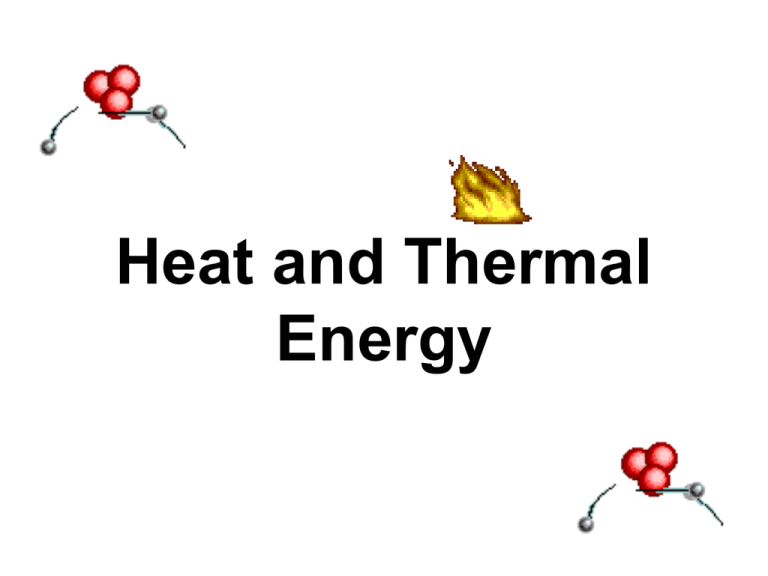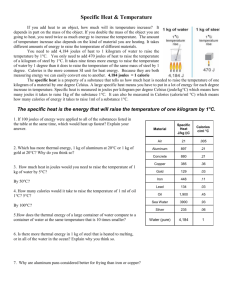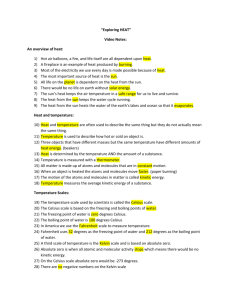Thermal Energy and Temperature
advertisement

Heat and Thermal Energy Temperature! • How hot or cold something is with respect to some standard Try this! What do you notice? A standard is a frame of reference that all agree on. If I asked you what temperature it was in the room, you’d all have different answers! But if I also gave you each a thermometer… Thermometers • Thermometers work through the expansion and contraction of a liquid • Usually mercury or alcohol In the U.S., we use Fahrenheit Most other countries use Celsius Where did the Fahrenheit scale come from? • Daniel Fahrenheit got water to the lowest possible temperature. He called this 32. • He then set the upper limit of his scale to body temperature, or 96 degrees. Off a bit! • Next he tested the strength of his thermometer by placing it in boiling water. He found it to read 212, thus the upper limit Anders Celsius •Revised the Fahrenheit scale to be more logical. •Used freezing and boiling points of water for the zero and one hundred markers. So, what does a thermometer do exactly? So, how does a thermometer work? Temperature is a measure of the AVERAGE KE of a substance • When atoms within a substance move faster, they have higher temperatures! This pencil was just sharpened Why does it have to be the AVERAGE Kinetic Energy? When you place a thermometer in a substance, heat flows from hot to cold until both have the same average KE’s The thermometer measures her temp. when heat flows from her head to the thermometer! Thermometers actually read their own temperatures. Can you explain why?? What makes something hot? How do you heat something up? What if I compressed the box? What happens to the temperature? So what makes something cold? Cold When air is cool, the molecules of water vapor move slowly. Hot Water vapor molecules in warm air move faster. They are less likely to join together. To change the temperature… WAIT!!!!!!!!!! • Not so fast! We forgot about KELVIN! So what’s Zero Oh it can get a lot colderon than the this! Kelvin scale? • Zero on the Kelvin scale is equal to ABSOLUTE ZERO • That’s when all molecular motion ceases • Basically it’s the coldest anything can get! There is no theoretical limit on how hot something could get Absolute Zero and temperature • Check out this webpage… • Is there an upper limit to the temperature scale?? • What do YOU think?? How do you convert from one scale to another? www.fordhamprep.org/gcurran/sho/sho/review/rev29a.htm Try some of these with your partner! How do you convert from one scale to another? C = (F – 32) 5/9 F = 1.8*C + 32 Pay attention to order of operations!! How do you convert from one scale to another? C = K - 273 K = C + 273 So what’s thermal energy? • The sum of all the KE’s of the individual particles of a substance Who’s got more thermal energy? OK then, what’s HEAT? • HEAT is when thermal energy is transferred from one object to another due to a temperature difference between them Heat always moves from: Heat Units! Joules It takes 4.184 Joules to raise the temperature of 1 g of water by 1 oC Heat Units! 1 calorie (cal) = amount of heat needed to raise the temperature of 1 g of water by 1 oC The scientific "calorie" is spelled with a "c". One "calorie" = 4.184 Joules ------------------------------------The "dieter's" calorie is spelled with a "C". One "Calorie" = 1000 calories • Because of the confusion between Calorie and calorie, joules is commonly used for a unit of thermal energy. 3000 calories of thermal energy enters each cup. The temperature of the water on the left rises by 30 Celsius degrees. By how much does the temperature of the water in the cup on the right rise? U.S.A. Specific Heat Capacity The specific heat of a substance is the quantity of energy needed to raise the temperature of 1g of the substance by 1°C. The pans are of a similar type but different size. Each pan is filled with water. They are placed on heaters having the same power. In which pan would the water boil first? This beaker contains 100 grams of water at 20°C. Let's see how the temperature changes as we add hot or cold water. This beaker contains 100 grams of water at 20°C. Let's add 100 grams of water at 60°C to our 100 grams sample at 20°C. What temperature would you expect for the mixture? What temperature would you expect for the mixture? 20, 30, 40, 50 ,60 http://www.chem.uiuc.edu/webFunChem/Gen ChemTutorials.htm •A penny, marble and foil are at the same temp. Substance Marble Specific Heat 0.90 Aluminum 0.215 Copper 0.092 •Which one stays hot longer after removal from the bath? Specific Heats of Various Substances Substance water (pure) wet mud Ice (0 °C) sandy clay dry air (sea level) quartz sand granite Specific Heat Specific Heat (cal/gram °C) (J/g °C) 1.00 0.60 0.50 0.33 0.24 0.19 0.19 4.186 2.512 2.093 1.381 1.005 2.95 2.94 Practice Problems! • Example 1: How much energy does it take to raise the temperature of 50 g of copper by 10 C? (c of copper is 0.385 J/gC) Example 2: If we add 30 J of heat to 10 g of aluminum, by how much will its temperature increase? (c for aluminum is 0.902 J/gC) Example 3: A 4 g substance loses 23 Joules of heat energy when the temperature falls from 35°C to 20°C. What is the specific heat of the substance? Here’s a website with a cool demo and some practice problems! OK then, tell me why it takes so long for water to warm up in the summer?? Calorimeters How do they work? • Specific heat of water (c) is known • Take a known mass of water at a known temperature • Heat a known mass of any substance • Place the substance into the water in the calorimeter and seal the lid • Watch the change in temperature • Use the equation • Amount of heat lost by substance equals amount of heat gained by water (Q) • Calculate (c) for the substance Online specific heat experiment Let's measure the specific heat of a piece of brass, aluminum or plastic. • http://www.chem.uiuc.edu/webFunChe m/GenChemTutorials.htm Click the material would you like to use. • When heat is added and the temperature increases, molecules move faster and in general, move apart. Why should I know about this? Someone needs to re-take driver’s ed! Thermal Expansion Why do railroad tracks have spaces in between the ties? http://www.fotosearch.com/ bigcomp.asp?path=CSP/C SP011/k0112770.jpg The spaces we are discussing are the small spaces; not the large ones you see here. Why do railroad tracks have spaces in between them? • On hot days, the tracks which are made of metal expand. If there weren’t any spaces, the metal would push on the adjoining pieces as they expand and cause a deformity in the track. When a train travels along the track and hits the problem area, it could derail, causing injury and destruction. Bimetallic Strips •½ is made of brass, ½ is made of iron •Can you tell which has the greater rate of expansion? HOW? •When the room temp. changes, the strip bends •It will either turn the switch on or off, turning the heat on or off Who’s weird?? When the molecules link up to make ice, they form a crystal So when it freezes, it Yes, way… that’s why ice floats on top of liquid water. Its… LESS DENSE Sorry… couldn’t resist! To sum up, when water freezes: • The molecules bond in a crystalline structure • Like Tinker Toys… when you put them together, they take up more space • When you take them apart, they take up less space! What’s the deal with the whole 4 degrees Celsius thing? • @ 5 C, if you heat water, it acts like any other substance and expands • BUT, if you cool it, the molecules contract until 4 C when they are the MOST dense (tightly packed) • As you cool it further, they EXPAND as polar bonds form and become LESS dense Why does this happen??? This is a GOOD thing… if water sank when it froze, what would happen to all of the fish? How does a pond freeze? • Water at the surface is cooled by surrounding air • Once it reaches 4 C, it sinks pushing warmer water to the surface • Then the next layer is cooled and then sinks at 4 C • The whole pond/ocean will not begin to freeze until the whole body of water has reached 4 C • Called “turning over” What does a solid “look” like vs. a gas or a liquid? As the temperature increases… so does the average KE! Molecules move faster, preventing bonds from holding together! Specific heats of some metals Aluminum Brass Copper Nickel Silver Steel Iron Gold 0.9025 0.39212 0.38452 0.54 0.237 0.5 0.46 0.129 Conductivity of some metals • • • • • Copper .97 Aluminum .63 Brass .26 Steel .12 Nickel Silver .07




